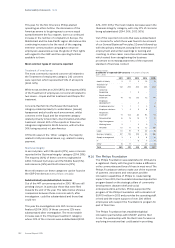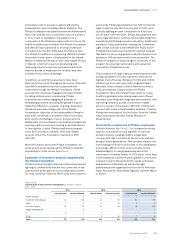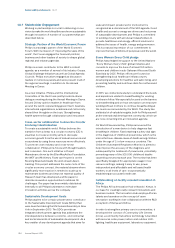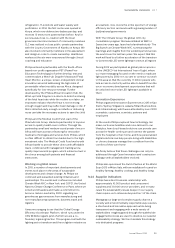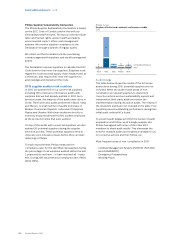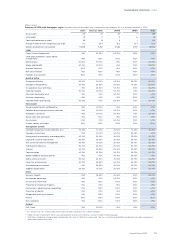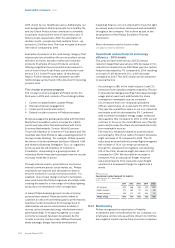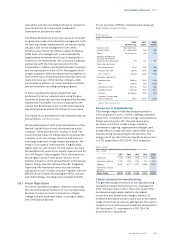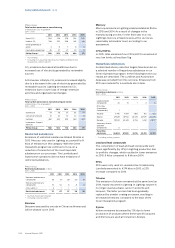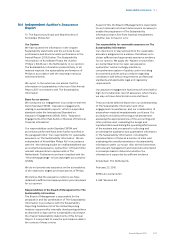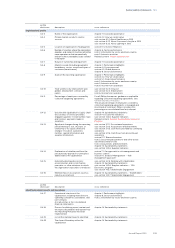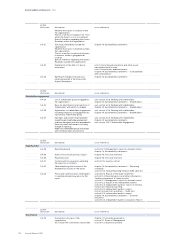Philips 2015 Annual Report Download - page 200
Download and view the complete annual report
Please find page 200 of the 2015 Philips annual report below. You can navigate through the pages in the report by either clicking on the pages listed below, or by using the keyword search tool below to find specific information within the annual report.
Sustainability statements 14.2.8
200 Annual Report 2015
Tin mining in Indonesia
Indonesia produces roughly one-third of the world’s tin
supply, of which the vast majority comes from the
islands Bangka and Belitung. The intensity of tin mining,
the illegal small-scale miners and the irresponsible way
it is carried out cause environmental devastation and
safety risks for miners.
Philips does not directly source tin from Indonesia and
there are typically 7 or more tiers in the supply chain
between a mine and a Philips supplier. Being highly
concerned about the situation, Philips teamed up with
other multinationals, the tin industry and civil society in
the Indonesian Tin Working Group (TWG), coordinated
by the Dutch Sustainable Trade Initiative.
The Tin Working Group has achieved several important
milestones in 2015, including an ocial written
endorsement of relevant Indonesian ministries and
securing a commitment of several front running mining
companies. In collaboration with the local industry and
government a roadmap to sustainable tin mining was
drafted, dening improvement areas for onshore land
reclamation and oshore low impact mining.
In 2016, implementation of the roadmap will start with
rst pilots kick o, governed by the local steering
committee. Philips was one of the rst companies to
commit to co-funding the next phase of TWG and to
support the sustainable mining practices through
promoting responsible sourcing in Philips supply chain.
“We (IDH, the Sustainable Trade Initiative) are very
impressed with the commitment and engagement
that Philips has showed over the past years as
member of the Tin Working Group to address the
non-sustainable tin mining practices in Bangka
island in Indonesia. This was again demonstrated in
December 2015 during the visit of a TWG delegation
to the Indonesian government and tin mining
representatives in which Philips actively participated
in the dialogue to create a systemic value chain
intervention. This is clearly CSR leadership behavior
from Philips!”
Ted van der Put
Program Director, IDH
Other sustainability initiatives in our supply
chain
Managing CO2 emissions in our supply chain
In addition to developing energy-ecient products and
becoming carbon-neutral by 2020, Philips will continue
to tackle scope 3 emissions in its upstream supply
chain. Via collaborative initiatives like the Carbon Pact,
supplier development projects with upstream partners
and by organizing awareness sessions for suppliers
Philips proactively initiates, develops and supports
carbon emission reduction activities in the supply chain.
Via collaborative initiatives like the Carbon Pact
between Philips and Mærsk Line, Supplier
Development projects with upstream partners and by
organizing awareness sessions for suppliers Philips
proactively initiates, develops and supports Carbon
Emission reduction activities in the supply chain.
Partnership in the Supply Chain
In 2015, Maersk Line and Philips expressed their
mutual values for achieving sustainable growth by
signing a Carbon Pact. As part of the Carbon Pact
Maersk and Philips intend to:
• Create transparency on the environmental
impact of the supply chain
• Reduce Philips'CO2 emissions per container
moved with Maersk Line by 20% from
2016-2020
• Integrate CO2 and other sustainability indicators
into the commercial relationship
Using the CDP Supply Chain program Philips has
reached out to over 500 suppliers (four times more than
in 2014), allowing information sharing on CO2 emissions
and climate strategies. As a founding member of the
CDP Action Exchange program we continued
connecting our suppliers to globally recognized
solutions providers in the eld of energy-ecient
technology. Our suppliers have indicated that this
initiative has been helpful in their search for innovative
solutions to reduce their footprint.
In 2016 we will stimulate and facilitate further
improvement in our supply chain. A growing number of
suppliers will be assisted in supplier development
projects using Lean methodologies to reduce energy
usage. Using the CDP platform Philips will continue to
connect to suppliers, monitoring development, sharing
best practices and identifying new improvement
opportunities.
Circular Procurement
Procurement is a key driver in the transition towards
embracing the concept of Circular Economy. Timely
decisions in the product creation process are a pre-
requisite to closing the materials loop at the end of the
product life, with products made for repair or
refurbishment and re-use from the start.
The focus is on innovative performance- or usage-
based business models replacing the traditional
“ownership” models. This is of course only possible
while nurturing long-term business relationships with
suppliers and customers.
In 2014, Philips joined Dutch
GreenDeal Circular Procurement, which is facilitated by
organizations such as MVO Nederland, NEVI, and the
Dutch government. Its goal is to accelerate the




